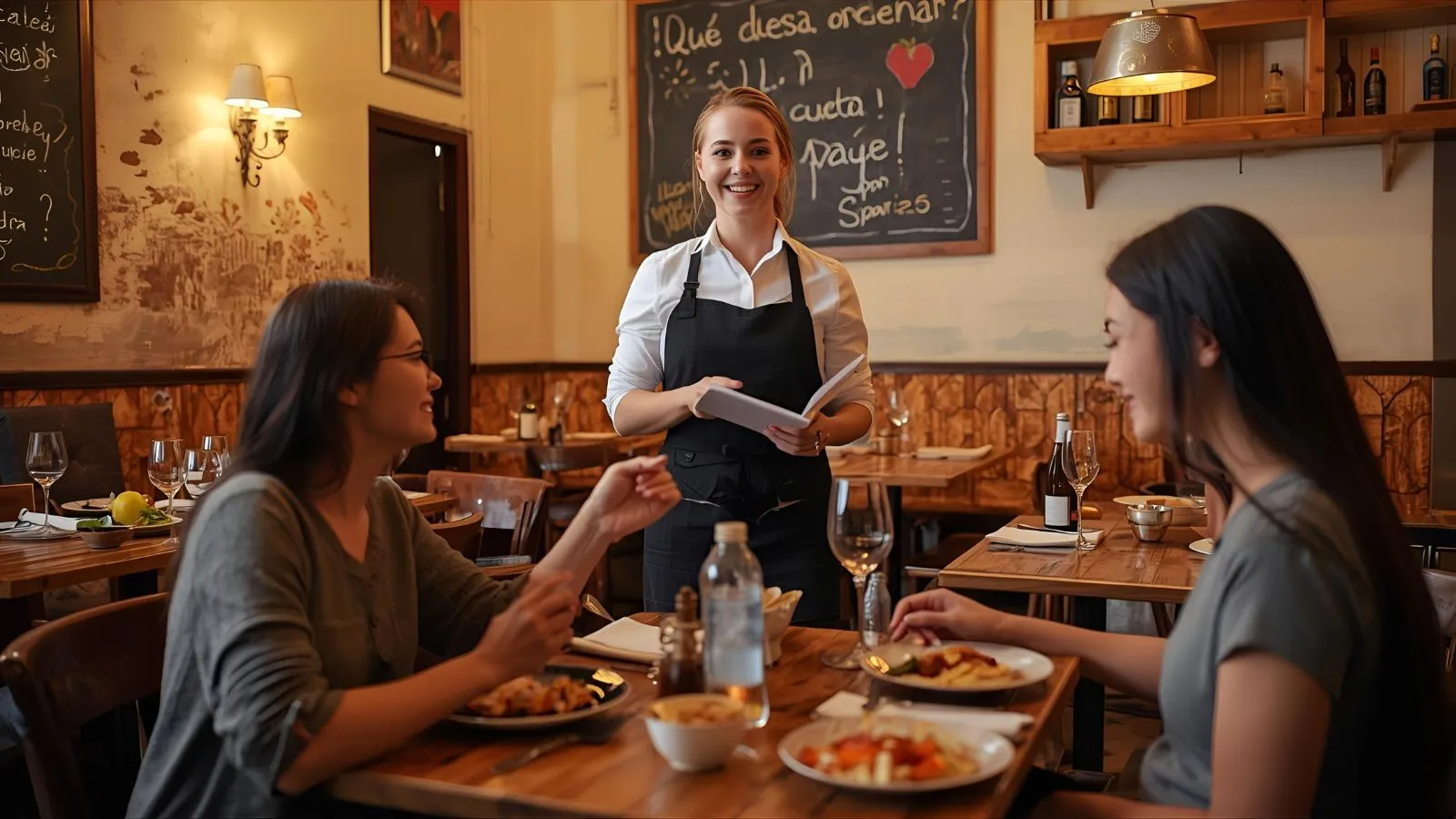Hey there! So, you’re either working in a restaurant or planning to visit one in a Spanish-speaking country, right?
Either way, knowing some useful Spanish phrases for restaurant situations can make your life so much easier.
Imagine confidently greeting Spanish-speaking customers, taking orders smoothly, or simply understanding what’s being asked it instantly makes interactions warmer and more professional.
In this guide, we’ll chat about the most practical and easy-to-remember Spanish phrases you can use every day at work or while dining out. Ready to sound more natural and confident when speaking Spanish?
Let’s dive in!
Why It Matters 🌮
Learning Spanish phrases for restaurant situations is more than just about ordering food it’s about building real connections. Spanish is one of the most spoken languages in the world, and restaurants are often the easiest place to practice it.
For travelers, knowing a few simple phrases can make the difference between a confusing meal and an amazing cultural experience.
For restaurant workers, these phrases improve communication with Spanish speaking customers, reduce misunderstandings, and create a welcoming environment.
So whether you’re eating, serving, or managing a restaurant, these Spanish restaurant phrases are your secret ingredient to smoother service and happier experiences.
Common Phrases for Ordering Food 🥗

When dining out, knowing how to order food politely in Spanish can help you sound confident and respectful.
“¿Me puede traer el menú, por favor?”
Meaning: Can you bring me the menu, please?
Use When: Asking for the menu after being seated.
Example:
“Hola, ¿me puede traer el menú, por favor?”
“Quisiera pedir…”
Meaning: I would like to order…
Use When: You’re ready to order your meal.
Example:
“Quisiera pedir una ensalada y un café.” (I’d like to order a salad and a coffee.)
“¿Cuál es el plato del día?”
Meaning: What’s the dish of the day?
Use When: Asking about daily specials.
Example:
“¿Cuál es el plato del día?”
“Para mí…”
Meaning: For me…
Use When: Informally placing your order.
Example:
“Para mí, una pizza margarita.”
“¿Me recomienda algo?”
Meaning: Do you recommend something?
Use When: Asking for the waiter’s suggestion.
Example:
“¿Me recomienda algo típico de aquí?”
Phrases for Waiters and Restaurant Workers 👨🍳

If you work in a restaurant and serve Spanish-speaking customers, these phrases will make you sound professional and welcoming.
“Bienvenido, ¿en qué puedo ayudarle?”
Meaning: Welcome, how can I help you?
Use When: Greeting a new customer.
Example:
“Bienvenido, ¿en qué puedo ayudarle hoy?”
“¿Qué le gustaría tomar?”
Meaning: What would you like to drink?
Use When: Asking for drink orders.
Example:
“¿Qué le gustaría tomar, agua o vino?”
“Su comida estará lista en unos minutos.”
Meaning: Your food will be ready in a few minutes.
Use When: Informing the customer about the wait time.
Example:
“Su comida estará lista en unos minutos, gracias por su paciencia.”
“¿Todo está bien con su comida?”
Meaning: Is everything okay with your food?
Use When: Checking in after serving.
Example:
“¿Todo está bien con su comida?”
“Aquí tiene la cuenta.”
Meaning: Here’s the bill.
Use When: Presenting the bill at the end of the meal.
Example:
“Aquí tiene la cuenta, muchas gracias por venir.”
Useful Kitchen and Staff Phrases 🔪
Behind the scenes, clear communication in Spanish keeps the kitchen running smoothly.
“Orden lista para servir.”
Meaning: Order ready to serve.
Use When: Informing waiters that the food is ready.
Example:
“Orden lista para servir, mesa cinco.”
“Necesitamos más pan.”
Meaning: We need more bread.
Use When: Requesting supplies from another staff member.
Example:
“Necesitamos más pan para la mesa dos.”
“Mesa tres quiere la cuenta.”
Meaning: Table three wants the bill.
Use When: Communicating table requests.
Example:
“Mesa tres quiere la cuenta, por favor.”
“Falta una bebida.”
Meaning: One drink is missing.
Use When: A drink order hasn’t been delivered.
Example:
“Falta una bebida para la mesa siete.”
“Limpia la mesa, por favor.”
Meaning: Clean the table, please.
Use When: Asking staff to prepare for the next guest.
Example:
“Limpia la mesa, por favor, llega un nuevo cliente.”
Polite Phrases for Better Service 💬
Politeness can make any restaurant interaction smoother.
“Por favor”
Meaning: Please.
Use When: Any time you make a request.
Example:
“Un poco de agua, por favor.”
“Gracias”
Meaning: Thank you.
Use When: After receiving food or service.
Example:
“Gracias por el excelente servicio.”
“Disculpe”
Meaning: Excuse me.
Use When: Getting someone’s attention.
Example:
“Disculpe, ¿me trae más servilletas?”
“Con permiso”
Meaning: Excuse me (to pass by).
Use When: Moving around in a crowded restaurant.
Example:
“Con permiso, necesito pasar.”
“Perdón”
Meaning: Sorry.
Use When: Apologizing or correcting a mistake.
Example:
“Perdón, me equivoqué con su orden.”
Phrases for Special Situations 🍰
Sometimes restaurant experiences have special requests or issues.
“Soy alérgico a…”
Meaning: I’m allergic to…
Use When: Informing staff about allergies.
Example:
“Soy alérgico a los mariscos.”
“¿Tiene opciones vegetarianas?”
Meaning: Do you have vegetarian options?
Use When: Asking about dietary needs.
Example:
“¿Tiene opciones vegetarianas en el menú?”
“Está demasiado salado.”
Meaning: It’s too salty.
Use When: Politely giving feedback.
Example:
“Perdón, está demasiado salado.”
“¿Puedo cambiar mi pedido?”
Meaning: Can I change my order?
Use When: Requesting a change.
Example:
“¿Puedo cambiar mi pedido por otro plato?”
“¿Puedo pagar con tarjeta?”
Meaning: Can I pay by card?
Use When: Asking about payment options.
Example:
“¿Puedo pagar con tarjeta o solo en efectivo?”
Expressions for Travelers ✈️
If you’re traveling to Spain or Latin America, these phrases will help you dine confidently anywhere.
“Una mesa para dos, por favor.”
Meaning: A table for two, please.
Use When: Requesting a table.
Example:
“Una mesa para dos, por favor.”
“¿Está incluido el servicio?”
Meaning: Is the service included?
Use When: Checking about the tip.
Example:
“¿Está incluido el servicio en la cuenta?”
“¿Dónde está el baño?”
Meaning: Where is the bathroom?
Use When: Asking for the restroom.
Example:
“Disculpe, ¿dónde está el baño?”
“La comida está deliciosa.”
Meaning: The food is delicious.
Use When: Complimenting the chef.
Example:
“La comida está deliciosa, gracias.”
“Nos puede traer más agua, por favor?”
Meaning: Can you bring us more water, please?
Use When: Requesting refills.
Example:
“¿Nos puede traer más agua, por favor?”
Bonus Recap Table 🧾
| Category | Spanish Phrase | Meaning | Use When |
|---|---|---|---|
| Ordering Food | ¿Me puede traer el menú? | Can you bring me the menu? | Asking for the menu |
| Waiters | ¿Qué le gustaría tomar? | What would you like to drink? | Taking drink orders |
| Kitchen | Orden lista para servir | Order ready to serve | Food is ready |
| Polite | Gracias | Thank you | Showing appreciation |
| Special Situations | ¿Puedo pagar con tarjeta? | Can I pay by card? | Asking about payment |
| Travelers | La comida está deliciosa | The food is delicious | Complimenting the meal |
Final Thoughts 🍷
Whether you’re a traveler exploring Spanish cuisine or a restaurant worker aiming to improve communication, learning Spanish phrases for restaurant use opens doors literally and figuratively.
It helps you connect with people, enjoy authentic experiences, and show cultural respect.
Use them naturally, and soon you’ll notice how much smoother your dining experiences become.

At QuickReply.com, speed meets smart communication! Instantly craft perfect replies, boost engagement, and save time. Your go-to hub for quick, witty, and professional message responses anytime!

Leave a Reply